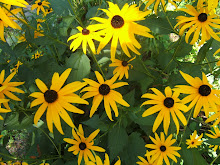A pleasant vignette shows a couple of farm workers piling loose hay into a wagon. The St.Lawrence river can be seen behind the field. The "villagers" do real farm work with the horses and oxen.
This is an unusual house. To me it looks like it should be in the South-west US. The fences around the houses and gardens provided protection from the farm animals who were often left to wander loose to eat grass where they could find it.
The tinsmith was busy at work producing household items. Tourists can purchase his wares at the gift shop.
I liked this picture that was being made out of dried flowers. The words at the bottom say, "Long Live the Queen."
The brooms are made from broom plants that are grown at the village.
The sawmill is a great place to see. I wish I had better pictures of it and that you could smell the delicious pine scent that permeates the building. The mill is powered by a water-mill placed in the small stream that runs through the village. Just to the left of the man is a large vertical saw blade. When he has finished placing the log, the blade will be engaged and move up and down cutting the log which is slowly moved along by a frame. The mill makes quite a bit of lumber which is then used in the village for various building projects.
I really like this cabin. It is so typical of the early settlers rough buildings. Notice the little eaves trough over the door. The cabins were small making them easier to heat in the winter. Heat was always provided by wood, and it was a lot of hard work to cut the trees down and into short lengths and then split the wood into manageable pieces. Even today, using a chain saw, cutting enough firewood for the winter is a lot of work.

















